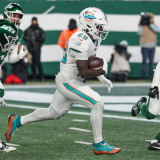
Agent's Take: The Packers' reckoning with Aaron Rodgers and an inside look at the star QB's three options
Aaron Rodgers can make one of three choices about his future; here's what each would mean

The Packers suffered a stunning 13-10 defeat to the 49ers in the divisional playoff round. As the NFC's No. 1 seed for the second straight season, an early playoff exit wasn't anticipated. With Green Bay's season over, quarterback Aaron Rodgers' football future moves to the forefront.
Rodgers is under contract through the 2022 season after his 2023 contract year was turned into a voiding/dummy year in an effort to end his offseason rift with the Packers, during which he contemplated retirement. "I don't want to be part of a rebuild if I'm going to keep playing," Rodgers said in a postgame session with the media. Packers leadership is unanimous in wanting Rodgers to return to Green Bay.
Rodgers originally indicated he would make his decision before free agency begins on March 16. He amended his timetable without giving a specific date Tuesday on The Pat McAfee Show. Rodgers suggested he would decide before the end of the franchise designation period to be sensitive to All-Pro wide receiver Davante Adams' situation. The 15 day window to designate franchise players runs from Feb. 22 through March 8. NFL Media's Ian Rapoport recently reported that the Packers intend to place a franchise tag on Adams. Rodgers has three choices: return to the Packers, demand a trade or retire.
Return to Packers
The issues that made Rodgers disgruntled won't be an impediment to him returning to the Packers. They are in the rear view mirror. A strained relationship with general manager Brian Gutekunst has dramatically improved since last offseason.
Green Bay having one of the NFL's most challenging salary cap situations could be a different story. Using NFLPA data, the Packers are $43.97 million over the agreed upon $208.2 million 2022 salary cap ceiling based on offseason accounting rules. Only the top 51 salaries (i.e.; cap numbers) matter with these rules. The Packers have 51 players under contract for the 2022 league year.
An Adams franchise tag at $20.12 million, which isn't included in the $43.97 million overage, would only compound Green Bay's cap problems. Some salary cap gymnastics with restructuring contracts and releasing players are going to necessary whether or not Adams is franchised.
Rodgers had an interesting response when asked on SiriusXM's The Adam Schein Podcast earlier this month about whether he's thought the grass might not be greener on the other side. He said, "The grass is greener where you water it." The Packers would be prohibitive favorites to win a fourth straight NFC North title even with some roster turnover because of free agency and the salary cap.
Rodgers playing out the final year of his contract isn't feasible because of Green Bay's salary cap situation and his $46,664,156 cap number in 2022, which is the NFL's second largest. He is scheduled to make to $26,970,588 in 2022 consisting of a $26,470,588 base salary and $500,000 workout bonus.
A contract extension where Green Bay gets significant 2022 cap relief would be in order with Rodgers returning. Rodgers reportedly rejected a Packers offer making him the NFL's highest paid player ahead of Chiefs quarterback Patrick Mahomes' $45 million per year during last offseason's rift. Since details weren't revealed, it's impossible to determine how team-friendly this offer was. Presumably, the Packers would still be willing to do same with a somewhat player-friendly structure, considering Rodgers is on the verge of winning back-to-back NFL MVP awards.
Rodgers' current contract signed in 2018 included a then-record $57.5 million signing bonus. Eclipsing Cowboys quarterback Dak Prescott's record-setting $66 million signing bonus might make sense under the circumstances, especially with a willingness from Rodgers to play well into his 40s as he previously stated on several occasions.
The Packers should be able to clear $10 million of 2022 space cap through a market value Rodgers extension. One way this could be done is by is lowering Rodgers' base salary to $1,470,588 while giving him a $75 million signing bonus on a four-year extension. There would be $15 million of new annual signing bonus proration from 2022 through 2026. Rodgers' 2022 cap number would drop from $46,664,156 to $36,664,156 in the process.
The ideal scenario for Green Bay would be for 38-year-old Rodgers, because of playoff shortcomings in recent years, to follow Drew Brees' path when he was in his late 30s. As a 39 year old, Brees gave the Saints a financial break for the first time in his numerous contract dealings with the franchise in 2018 to try to maximize his opportunity to win a second Super Bowl ring. Brees probably could have become the league's first $30 million per year player had he exploited his leverage by exploring potential options with other teams. Instead, Brees signed a two-year, $50 million contract with $27 million fully guaranteed to remain in New Orleans after limiting negotiations to just the Saints.
$25 million per year represented a 3.09% increase over the one-year extension Brees signed in 2016. A new deal would be in the $35 million per year neighborhood with Rodgers, whose lone Super Bowl appearance and win was in the 2010 season, taking a similar approach. The cap relief should be much greater without Rodgers continuing to maximize his earnings because the signing bonus wouldn't need to be as large.
Demand a trade
The Packers would be reluctantly trading Rodgers since the organizational consensus is to keep him in the fold. A trade might change the calculus with Adams. He's hinted that he would probably want to follow Rodgers out the door. 2020 first round pick Jordan Love doesn't seem nearly as ready to become the starting quarterback as Rodgers was when Hall of Famer Brett Favre was dealt to the Jets in 2008. Franchising Adams with the purpose of trading him would become a viable option.
The acquisition cost for Rodgers should be less than the reported three first round picks and two second round picks the Texans have wanted in exchange for Deshaun Watson, who is 26, given the 12 year age difference between the two players. Watson is also already under contract through the 2025 season for $136 million, which is an average of $34 million per year.
The Packers should be able to get more in return for Rodgers than teams have with Pro Bowl caliber non-quarterbacks in recent years. For example, the Texans gave up a 2020 first round pick (26th overall), a 2021 first round pick (third overall), a 2021 second round pick (36th overall), safety Johnson Bademosi and offensive tackle Julie'n Daveport in exchange for offensive tackle Laremy Tunsil, wide receiver Kenny Stills, a 2020 fourth round pick and a 2021 sixth round pick in the days leading up to the start of the 2019 season.
The acquiring team would need $26,970,588 of cap space to absorb Rodgers' 2022 salary. The Packers would pick up $19,817,018 of cap space with the trade. There would be $26,847,138 of dead money, which is a salary cap charge for a player no longer on a team's roster. It would come from the $19,173,568 of 2022 bonus proration relating to his $57.5 million signing bonus, the $14.26 million converted into signing bonus during a December 2019 contract restructure, the $14,464,706 of signing bonus in the July 2021 restructure and $7,637,570 of bonus proration associated with the voiding/dummy 2023 contract year. Presumably, the trade would occur before the start of the 2022 NFL Draft on April 28 because the Packers would want immediate draft capital.
A contract extension would likely be a necessity since 2022 is Rodgers' contract year. The acquiring team also would be precluded from using a franchise tag on Rodgers because his 2023 contract year doesn't void until the 2023 designation window has closed. Assuming Rodgers would insist upon being the league's highest paid player, his 2022 cap number could at least be cut in half depending on the size of his signing bonus.
Rodgers reportedly had his sights set on playing for the Broncos last offseason before mending fences with the Packers. Green Bay offensive coordinator Nathaniel Hackett is a finalist for the Broncos head coaching vacancy. His hiring would make Denver an even more attractive destination to Rodgers.
Retire
It's hard to imagine Rodgers retiring. The reigning MVP retiring is almost unprecedented. The only time it has ever happened was when Hall of Fame running back Jim Brown hung up his cleats in 1966 after winning the award in 1965.
Retirement would be permanent. Rodgers has dismissed sitting out a season and then making a comeback.
Rodgers would probably work with the Packers, like Brees did with the Saints last year when he retired, for optimal cap treatment. This would consist of Rodgers creating $26,470,588 of immediate cap space by lowering his 2022 base salary to his $1.12 million league minimum salary while also eliminating his $500,000 workout bonus and $520,000 of incentives deemed likely to be earned that have a cap charge. The Packers would carry Rodgers on the roster until at least June 2 to keep the $7,637,570 in bonus proration relating to his voiding 2023 contract year from becoming a 2022 cap charge. It would be 2023 dead money. At this point, Rodgers would be placed on the reserve/retired list and his $1.12 million base salary would also come off the books for additional cap relief.
The Packers could pick up more cap room by exercising rights for repayment of the $11.5 million in 2022 signing bonus proration from Rodgers' 2018 signing bonus. Demanding repayment would be a sure fire way to alienate Rodgers.

















